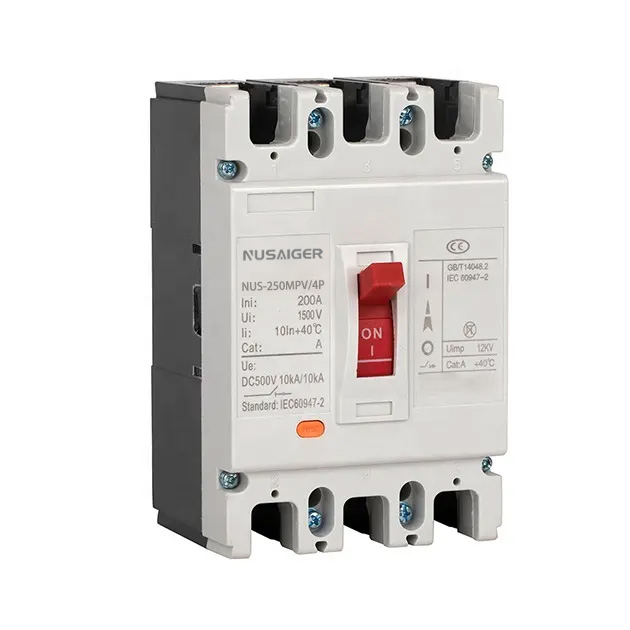Selecting the Right DC Molded Case Circuit Breaker for Solar, EV Charging & Energy Storage Applications
1. Understanding Your Use Case
Begin selection by profiling the application: is it a PV array, an EV fast charger, or an energy storage system (ESS)? Each scenario has unique requirements in voltage range (e.g. 600 VDC PV vs 1500 VDC battery), current levels, and fault-clearing needs. EV charging systems often require DC breakers with faster interrupt ratings due to varying load profiles and higher environmental stress. Meanwhile, ESS installations demand high short-circuit capacity and arc fault mitigation strategies due to bidirectional DC flows.
2. Key Technical Specifications to Evaluate
When comparing DC MCCBs, examine:
- Rated voltage: Match system voltage (common 600 V, 1000 V, 1500 V).
- Frame and adjustable current range: Choose frame size that covers future expansion.
- Interrupting capacity (kA): Must exceed worst-case fault current.
- Trip curve (B, C, D): Protective curve suited to cable inrush vs fault condition.
- Number of poles: Single or multipole options for common return lines.
3. Manufacturer Comparison and Models
Schneider Electric / Square D
Their EH/EV/ELX DC-rated MCCBs support up to 1500 VDC, feature electronic trip units with Modbus telemetry, and offer breaking capacities up to 65 kA with arc isolation barriers. Widely used in industrial PV farms and ESS installations.
Siemens 3VA & 3WL Series
Siemens DC MCCBs provide adjustable trip units, thermal-magnetic protection, and UL DC tested designs—ideal for EV fast chargers and renewable energy systems in North America and Asia.
Eaton Series-B and HFD
Eaton offers high-interrupting format breakers optimized for DC applications; the HFD product line includes UL-listed 1500 VDC breakers capable of 100 kA interrupting capacity.
4. Matching DC MCCB Features to Applications
| Application | Recommended Breaker Specs | Key Requirements |
|---|---|---|
| Residential Solar (600 VDC) | 2‑pole, 10–20 A, 25 kA | String isolation, surge protection interface |
| Commercial Solar (1000 VDC) | 3‑pole, 50 A, 35–50 kA | High fault capacity, optional remote trip |
| EV Fast Charger (600–1500 VDC) | Single‑/two‑pole, dynamic current, ≥65 kA | Rapid trip, temperature resistance, compact form |
| Utility‑Scale ESS (1500 VDC) | 4‑pole, 200 A, ≥80 kA | Bi-directional blocking, arc fault detection, telemetry |
5. Installation Considerations for Each Use Case
Different applications demand specific mitigation tactics. For EV stations, breaker’s ambient rating and IP/IK protection for outdoor installation are crucial. Solar combiner boxes require proper DC cabling, torque-checked terminals, and thermal treatment for string grouping. In ESS modules, breakers may be used inside battery cubicles, needing arc-rated doors, lockout devices, and remote trip integration.
6. Maintenance, Testing and Lifecycle Cost
Review maintenance cycles: thermal imaging to detect hotspots, trip calibration checks, manual operation testing, and arc chute inspection. Evaluate the total cost of ownership, including replacement parts, warranty length (commonly 3–10 years), and local support network availability.
7. Common Selection Mistakes to Avoid
- Mixing AC and DC breakers without DC testing certification
- Selecting insufficient interrupting capacity, causing failure in fault events
- Ignoring temperature derating and altitude de-rating tables
- Failing to account for bidirectional current in battery systems
- Underestimating remote-trip or arc-fault integration needs
8. Case Study: EV Charging Station Deployment
An EV fast charging hub deployed DC MCCBs rated at 1,000 VDC with 70 kA interrupting capacity, plus onboard remote trip logic tied into the site BMS. The correct selection prevented a system-wide fault during a short-circuit event, where an adjacent breaker isolated the fault without system shutdown.
9. Future Trends: Smart DC MCCBs & IoT Integration
Emerging products feature built-in sensors for current, voltage, temperature, and remote trip via Modbus/Wi‑Fi. These “smart breakers” reduce fault response time and enable predictive maintenance. Demand is growing particularly in utility PV and ESS deployments.
10. Conclusion
Choosing the right DC MCCB hinges on matching technical specifications with system requirements. Evaluating rated voltage, interrupting capacity, trip characteristics, and smart features is essential across applications like solar, EV, and storage. Proper selection reduces downtime, improves safety, and extends system lifespan.



